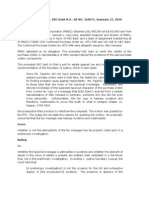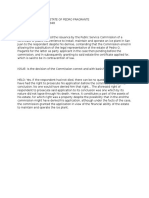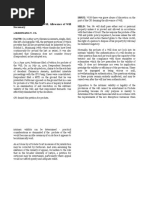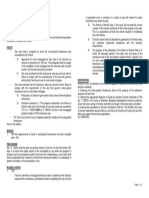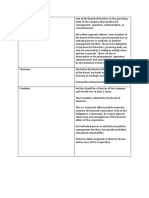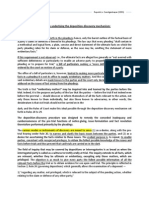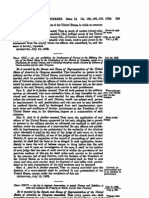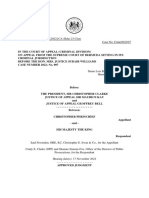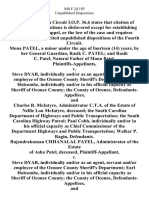Limpin V IAC
Limpin V IAC
Uploaded by
Coco LocoCopyright:
Available Formats
Limpin V IAC
Limpin V IAC
Uploaded by
Coco LocoOriginal Description:
Original Title
Copyright
Available Formats
Share this document
Did you find this document useful?
Is this content inappropriate?
Copyright:
Available Formats
Limpin V IAC
Limpin V IAC
Uploaded by
Coco LocoCopyright:
Available Formats
Civil Procedure Case Digest AY 13-14
134 Limpin v IAC G.R. No. 70987 September 29, 1988 TOPIC: Foreclosure of Real Estate Mortgage PONENTE: Narvasa, J. FACTS: 1. 1973: Two lots (TCTs Nos. 92836 and 92837) were mortgaged (plus 2 other lots, 4 in all) in 1973 to private respondent Ponce by their former owners, the Spouses Jose and Marcelina Aquino. 2. 1978: The said 2 lots were sold by the Aquino spouses to Butuan Bay Wood Export Corporation. 3. Petitioner Limpin obtained a money judgment in 1979 against the corporation and to satisfy the judgment, the two lots were levied on and sold at public auction in 1980; Limpin was the highest bidder. Limpin later sold the lots to his copetitioner, Sarmiento. 4. Before the levy was made on the two lots in execution of the judgment against the corporation, Ponce had initiated judicial proceedings for the foreclosure of the mortgage over said two (2) lots (together with the 2 others mortgaged to him. 5. Judgment was rendered in his favor and became final; and at the ensuing foreclosure sale, the lots were acquired by Ponce himself as highest bidder. 6. Ponce then moved for confirmation of the foreclosure sale, but the Court confirmed the sale of only two lots, refusing to do so as regards the two which had been subject of the execution sale in Limpin's favor (those covered TCTs Nos. 92836 and 92837). 7. Ponce instituted a special civil action in the Intermediate Appellate Court, impleading Limpin and Sarmiento a indispensable parties respondents. That Court rendered judgment in Ponce's favor; Limpin and Sarmiento appealed; this Court denied their appeal. 8. SC affirmed appellate courts decision and ordered the trial Court "to confirm the sale (of the lots formerly covered by TCT Nos. 92836 and 92837) and issue a writ of possession to Ponce with respect to the aforesaid lots, subject to the equity of redemption of Sarmiento. 9. Sarmiento knew that he had the prerogative to exercise his equity of redemption but he did not try to exercise that right before the confirmation of the foreclosure sale by Judge Solano. Instead, he instituted no less than two (2) actions in the RTC attempting to relitigate precisely the same issues which this Court and the IAC had already passed upon and resolved adversely to him. The cases were dismissed. 10. March 11, 1988: nine months or so after entry of the judgment recognizing his equity of redemption as successor-ininterest of the original mortgagors that Sarmiento finally attempted to exercise his unforeclosed equity of redemption. He filed a motion with the Court manifesting that he would exercise the right and asked the Court to fix the redemption price. The Court opined that "this should be the subject of the agreement between Ponce and Sarmiento. 11. Sarmiento then wrote to Ponce offering P2.6 million as redemption price for the two lots. Ponce rejected the offer said averred "that the period within which Sarmiento could have exercised such right had lapsed. According to Ponce, from October 17, 1982, when Sarmiento's predecessors-in-interest defaulted in their obligations over the mortgaged properties, up to June 17, 1987, when the trial court confirmed the auction sale of those properties, Sarmiento could (and should) have exercised his equity of redemption. ISSUE: WON the equity of redemption recognized in favor of petitioner Sarmiento still subsists and may be exercised, more than a year after that judgment had become final and executory. HELD: No. The equity of redemption lapsed and ceased to exist without having been properly exercised. After such order of confirmation of the foreclosure sale, no redemption can be effected any longer. RATIO: 1. The equity of redemption is, to be sure, different from and should not be confused with the right of
Civil Procedure Case Digest AY 13-14
redemption. The right of redemption in relation to a mortgage, understood in the sense of a prerogative to re-acquire mortgaged property after registration of the foreclosure sale, exists only in the case of the extrajudicial foreclosure of the mortgage. No such right is recognized in a judicial foreclosure except only where the mortgagee is the Philippine National Bank or a bank or banking institution.
Where a mortgage is foreclosed extra-judicially, Act 3135 grants to the mortgagor the right of redemption within one (1) year from the registration of the sheriffs certificate of foreclosure sale.
Where the foreclosure is judicially effected, however, no equivalent right of redemption exists. The law declares that a judicial foreclosure sale, "when confirmed by an order of the court, shall operate to divest the rights of all the parties to the action and to vest their rights in the purchaser, subject to such rights of redemption as may be allowed by law. Such rights exceptionally "allowed by law" (i.e., even after confirmation by an order of the court) are those granted by the charter of the Philippine National Bank (Acts No. 2747 and 2938), and the General Banking Act (R.A. 337). These laws confer on the mortgagor, his successors in interest or any judgment creditor of the mortgagor, the right to redeem the property sold on foreclosure-after confirmation by the court of the foreclosure sale-which right may be exercised within a period of one (1) year, counted from the date of registration of the certificate of sale in the Registry of Property. 2. But, to repeat, no such right of redemption exists in case of judicial foreclosure of a mortgage if the mortgagee is not the PNB or a bank or banking institution. In such a case, the foreclosure sale, "when confirmed by an order of the court shall operate to divest the rights of all the parties to the action and to vest their rights in the purchaser." There then exists only what is known as the equity of redemption. This is simply the right of the defendant mortgagor to extinguish the mortgage and retain ownership of the property by paying the secured debt within the 90-day period after the judgment becomes final, in accordance with Rule 68, or even after the foreclosure sale but prior to its confirmation. Section 2, Rule 68 provides that
... If upon the trial ... the court shag find the facts set forth in the complaint to be true, it shall ascertain the amount due to the plaintiff upon the mortgage debt or obligation, including interest and costs, and shall render judgment for the sum so found due and order the same to be paid into court within a period of not less than ninety (90) days from the date of the service of such order, and that in default of such payment the property be sold to realize the mortgage debt and Costs.
After such order of confirmation, no redemption can be effected any longer. 3. It is this same equity of redemption that is conferred by law on the mortgagor's successors-in-interest, or third persons acquiring rights over the mortgaged property subsequent, and therefore subordinate, to the mortgagee's lien. If these subsequent or junior lienholders be not joined in the foreclosure action, the judgment in the mortgagor's favor is ineffective as to them, of course. In that case, they retain what is known as the "unforeclosed equity of redemption," and a separate foreclosure proceeding should be brought to require them to redeem from the first mortgagee, or the party acquiring title to the mortgaged property at the foreclosure sale, within 90 days. In the case at bar, however, there is no occasion to speak of any "unforeclosed equity of redemption' in Sarmiento's favor since he was properly impleaded in the judicial proceeding where his and Ponce's rights over the mortgaged property were ventilated and specifically adjudicated. 4. Under the circumstances obtaining in this case, the plain intendment of the IAC was to give to Sarmiento, not the unforeclosed equity of redemption pertaining to a stranger to the foreclosure suit, but the same equity of redemption possessed by the mortgagor himself. The judgment cannot be construed as contemplating or requiring the institution of a separate suit by Ponce to compel Sarmiento to exercise his unforeclosed equity of redemption, or as granting Sarmiento the option to redeem at any time that he pleases, subject only to prescription. This would give rise to that multiplicity of proceedings which the law eschews. The judgment plainly intended that Sarmiento exercise his option to redeem, as successor of the mortgagor. CASE LAW/ DOCTRINE: see highlighted words in the ratio part (Limpin v IAC)
Civil Procedure Case Digest AY 13-14
You might also like
- Cancellation of Deed of Absolute SaleDocument2 pagesCancellation of Deed of Absolute SaleCoco Loco94% (35)
- Business Tax Protest LetterDocument2 pagesBusiness Tax Protest LetterCoco Loco76% (17)
- Sample Board Resolution (Authorized Representative DOLE)Document1 pageSample Board Resolution (Authorized Representative DOLE)Coco Loco67% (15)
- Bazaar Rules/GuidelinesDocument6 pagesBazaar Rules/GuidelinesCoco Loco25% (4)
- Call Option Agreement TemplateDocument18 pagesCall Option Agreement TemplateCoco LocoNo ratings yet
- Appeal Letter Company NameDocument1 pageAppeal Letter Company NameCoco Loco80% (5)
- 23 Calo vs. RoldanDocument2 pages23 Calo vs. RoldanGilbert Yap100% (1)
- Sample Loan AgreementDocument4 pagesSample Loan AgreementCoco LocoNo ratings yet
- Gibbins v. Proctor (1918) 13 CR App Rep 134Document4 pagesGibbins v. Proctor (1918) 13 CR App Rep 134Nuratiah ZakariaNo ratings yet
- Martinez v. Morfe - DigestDocument2 pagesMartinez v. Morfe - DigestMaria Angela Gaspar100% (1)
- The MCC Laws of Cricket-4th-Edition-2010Document159 pagesThe MCC Laws of Cricket-4th-Edition-2010saikatchoudhuriNo ratings yet
- Limpin vs. IACDocument2 pagesLimpin vs. IACAnonymous bOncqbp8yi100% (1)
- Fortunata Vs CADocument4 pagesFortunata Vs CAHiroshi Carlos100% (1)
- G.R. No. 155849 August 31, 2011 Lorenzo Shipping Corporation, vs. Distribution Association Management of The PhilippinesDocument15 pagesG.R. No. 155849 August 31, 2011 Lorenzo Shipping Corporation, vs. Distribution Association Management of The PhilippinesDrew DalapuNo ratings yet
- Wang Laboratories, Inc. vs. Mendoza FactsDocument2 pagesWang Laboratories, Inc. vs. Mendoza FactsaudreyracelaNo ratings yet
- Philippine American Life vs. BrevaDocument6 pagesPhilippine American Life vs. BrevaSyElfredGNo ratings yet
- Spouses Dela Cruz Vs Spouses AndresDocument2 pagesSpouses Dela Cruz Vs Spouses AndresAurora Pelagio Vallejos100% (1)
- San Miguel Corporation v. Monasterio (NGO and TERO)Document1 pageSan Miguel Corporation v. Monasterio (NGO and TERO)Cal NgoNo ratings yet
- Torres vs. Specialized PackagingDocument4 pagesTorres vs. Specialized PackagingNicole Dagohoy TaytayanNo ratings yet
- Santiago v. CA DigestDocument2 pagesSantiago v. CA DigestColleenNo ratings yet
- Purcon Vs MRM Philippines IncDocument1 pagePurcon Vs MRM Philippines IncPao LucNo ratings yet
- Digest - Martelino vs. NHMFDocument2 pagesDigest - Martelino vs. NHMFKaye Mendoza100% (2)
- Civ Pro 2Document35 pagesCiv Pro 2Tammy YahNo ratings yet
- (D) Samuel U. Lee vs. KBC Bank N.V., GR NO. 164673, Juanuary 15, 2010Document2 pages(D) Samuel U. Lee vs. KBC Bank N.V., GR NO. 164673, Juanuary 15, 2010edwardmlimNo ratings yet
- Case Digest Gerilla VS Carolina Vda. de Figuracion, Et Al (Rule 73)Document2 pagesCase Digest Gerilla VS Carolina Vda. de Figuracion, Et Al (Rule 73)joy dayag100% (1)
- ChingDocument4 pagesChingakimoNo ratings yet
- 001d G.R. No. 158407 Domagas V JensenDocument1 page001d G.R. No. 158407 Domagas V JensenrodolfoverdidajrNo ratings yet
- Constantino A. Pascual, Substituted by His Heirs, Represented by Zenaida PascualDocument2 pagesConstantino A. Pascual, Substituted by His Heirs, Represented by Zenaida PascualJei Essa Almias100% (1)
- Glenn Caballes Vs CADocument9 pagesGlenn Caballes Vs CAXtine CampuPotNo ratings yet
- Marcelo vs. Sandiganbayan 531 SCRA 385Document7 pagesMarcelo vs. Sandiganbayan 531 SCRA 385lexington22No ratings yet
- Remedial Law 1 Case Digests 1 4Document9 pagesRemedial Law 1 Case Digests 1 4lou017No ratings yet
- Case Digests On Civil Procedure (Part III)Document16 pagesCase Digests On Civil Procedure (Part III)Danniel James Ancheta100% (4)
- Office of The Ombudsman Vs Ibay - G.R. No. 137538. September 3, 2001Document5 pagesOffice of The Ombudsman Vs Ibay - G.R. No. 137538. September 3, 2001Ebbe DyNo ratings yet
- Biaco v. Phil. Countryside Rural BankDocument1 pageBiaco v. Phil. Countryside Rural BankKaira CarlosNo ratings yet
- Dasmarinas Garments Inc V ReyesDocument2 pagesDasmarinas Garments Inc V ReyesKristine VillanuevaNo ratings yet
- Limjoco v. Intestate Estate of Pedro FragranteDocument1 pageLimjoco v. Intestate Estate of Pedro FragrantekrisNo ratings yet
- Tan V Dela VegaDocument2 pagesTan V Dela VegaAmber Barrett100% (1)
- Case Digest - Davao Light V CADocument1 pageCase Digest - Davao Light V CACherry ChaoNo ratings yet
- Santiago vs. CAdocxDocument3 pagesSantiago vs. CAdocxAce MarjorieNo ratings yet
- Samonte V Naguiat IncDocument1 pageSamonte V Naguiat IncMharey Almacha100% (1)
- La Naval Drug Corporation VDocument2 pagesLa Naval Drug Corporation VJose BautistaNo ratings yet
- Medado V ConsingDocument3 pagesMedado V ConsingKatrina Ysobelle Aspi HernandezNo ratings yet
- Rule 75 - CASE DIGEST COMPILATION (COMPLETE)Document9 pagesRule 75 - CASE DIGEST COMPILATION (COMPLETE)Eduard RiparipNo ratings yet
- Rule 53Document5 pagesRule 53Amiel SecretarioNo ratings yet
- Samonte Vs Naguiat Rule38Document2 pagesSamonte Vs Naguiat Rule38Remmon MasanguidNo ratings yet
- 06 Bongato Vs MalvarDocument3 pages06 Bongato Vs MalvarRudejane TanNo ratings yet
- Cabang V Basay PDFDocument3 pagesCabang V Basay PDFDwyane Yra DinglasanNo ratings yet
- 7) Yau Vs Silverio - Rodriguez (D2017)Document2 pages7) Yau Vs Silverio - Rodriguez (D2017)Maria Alyssa RodriguezNo ratings yet
- Merrill Lynch Futures Inc Vs Court of Appeals Spouses Pedro M Lara and Elisa G LaraDocument2 pagesMerrill Lynch Futures Inc Vs Court of Appeals Spouses Pedro M Lara and Elisa G LaraClaude PeñaNo ratings yet
- Puyat vs. Zabarte PDFDocument2 pagesPuyat vs. Zabarte PDFJona Calibuso100% (1)
- 3 DigestDocument2 pages3 DigestRey Almon Tolentino AlibuyogNo ratings yet
- Fortune Corp v. CaDocument2 pagesFortune Corp v. CaErikha AranetaNo ratings yet
- Olib Vs Pastoral CivproDocument5 pagesOlib Vs Pastoral CivproMaila C. MarañonNo ratings yet
- Civil Procedure Case Digests Part2Document76 pagesCivil Procedure Case Digests Part2LoisRenielPenadosNo ratings yet
- Wang v. MendozaDocument2 pagesWang v. MendozaRaymond Roque50% (2)
- Vera vs. Rigor, G.R. No. 147377, August 10, 2007Document2 pagesVera vs. Rigor, G.R. No. 147377, August 10, 2007claire beltranNo ratings yet
- Katon Vs Palanca (RTC)Document2 pagesKaton Vs Palanca (RTC)KitsRelojoNo ratings yet
- Pascual v. Pascual (607 SCRA 288) 12/4/2009Document2 pagesPascual v. Pascual (607 SCRA 288) 12/4/2009Manuel Rodriguez IINo ratings yet
- San Jose v. CADocument1 pageSan Jose v. CAGCNo ratings yet
- 41 Steel Corporation v. Equitable PCIBankDocument3 pages41 Steel Corporation v. Equitable PCIBankLouis Belarma100% (2)
- Sixto Chu vs. Mach Asia Trading Corp. (GR 184333, April 1 2013)Document1 pageSixto Chu vs. Mach Asia Trading Corp. (GR 184333, April 1 2013)Earl LarroderNo ratings yet
- Petitioners, VS.: RespondentsDocument2 pagesPetitioners, VS.: RespondentsErikha AranetaNo ratings yet
- Centennial Guarantee Assurance Corporation Vs Universal MotorsDocument5 pagesCentennial Guarantee Assurance Corporation Vs Universal MotorsEl G. Se ChengNo ratings yet
- Neypes Vs CADocument2 pagesNeypes Vs CAEdison FloresNo ratings yet
- TAN Vs KaakbayDocument11 pagesTAN Vs KaakbayaaaNo ratings yet
- Fairland Knitcraft vs. Po - DigestDocument3 pagesFairland Knitcraft vs. Po - DigestJanice F. Cabalag-De VillaNo ratings yet
- Day 10 - Millado Dan 2Document14 pagesDay 10 - Millado Dan 2Dan R. MilladoNo ratings yet
- Limpin Vs IACDocument10 pagesLimpin Vs IACStefan SalvatorNo ratings yet
- Limpin V IACDocument8 pagesLimpin V IACJoyce KevienNo ratings yet
- Petitioners Respondents Danilo A. Basa Angara, Abello, Concepcion, Regala & Cruz Law O Ces Sycip, Salazar, Hernandez & Gatmaitan Law O Ces Eugenio C. LindoDocument9 pagesPetitioners Respondents Danilo A. Basa Angara, Abello, Concepcion, Regala & Cruz Law O Ces Sycip, Salazar, Hernandez & Gatmaitan Law O Ces Eugenio C. LindoArste GimoNo ratings yet
- DirectorDocument2 pagesDirectorCoco LocoNo ratings yet
- Letter of CancellationDocument1 pageLetter of CancellationCoco LocoNo ratings yet
- Domestic Corporations (Subsidiary)Document3 pagesDomestic Corporations (Subsidiary)Coco LocoNo ratings yet
- Waiver - WFHDocument1 pageWaiver - WFHCoco LocoNo ratings yet
- Contract of Lease RenewalDocument2 pagesContract of Lease RenewalCoco LocoNo ratings yet
- Call Option Agreement: Document 1451ADocument9 pagesCall Option Agreement: Document 1451ACoco LocoNo ratings yet
- Levi Strauss & Co. vs. Clinton ApparelleDocument4 pagesLevi Strauss & Co. vs. Clinton ApparelleCoco Loco75% (4)
- Cristobal v. LabradorDocument2 pagesCristobal v. LabradorCoco Loco0% (1)
- Succession 2014-2015Document14 pagesSuccession 2014-2015Coco LocoNo ratings yet
- First Fil-Sin Lending Corp. v. PadilloDocument2 pagesFirst Fil-Sin Lending Corp. v. PadilloCoco Loco100% (1)
- Anthony S. Yu, Et Al, V. Joseph S. Yukayguan Et Al.Document3 pagesAnthony S. Yu, Et Al, V. Joseph S. Yukayguan Et Al.Coco Loco100% (1)
- Atlas Consolidated Mining and Development Corporation v. CIRDocument7 pagesAtlas Consolidated Mining and Development Corporation v. CIRCoco LocoNo ratings yet
- CIR v. Seagate Technology (Philippines)Document3 pagesCIR v. Seagate Technology (Philippines)Coco LocoNo ratings yet
- CBA Until Strikes and LockoutsDocument6 pagesCBA Until Strikes and LockoutsCoco LocoNo ratings yet
- Estrada Vs Sandiganbayan: J. Mendoza's OpinionDocument18 pagesEstrada Vs Sandiganbayan: J. Mendoza's OpinionCoco LocoNo ratings yet
- Notes:Doctrine - Republic v. SandiganbayanDocument2 pagesNotes:Doctrine - Republic v. SandiganbayanPink OrangeNo ratings yet
- Admin Law Midterm ReviewerDocument8 pagesAdmin Law Midterm ReviewerRaine VerdanNo ratings yet
- Borromeo V SunDocument2 pagesBorromeo V SunPablo Jan Marc FilioNo ratings yet
- La Abra Silver Mining Co. v. United States, 175 U.S. 423 (1899)Document56 pagesLa Abra Silver Mining Co. v. United States, 175 U.S. 423 (1899)Scribd Government DocsNo ratings yet
- 1861 ConfiscationAct 12stat589Document4 pages1861 ConfiscationAct 12stat589ncwazzyNo ratings yet
- LImketkai Sons Milling v. Court of Appeals (261 SCRA 464)Document11 pagesLImketkai Sons Milling v. Court of Appeals (261 SCRA 464)KriszanFrancoManiponNo ratings yet
- Norman L. Desmarais v. Jhelum Enterprises, LLC, 11th Cir. (2013)Document3 pagesNorman L. Desmarais v. Jhelum Enterprises, LLC, 11th Cir. (2013)Scribd Government DocsNo ratings yet
- The Case of The Speluncean ExplorersDocument7 pagesThe Case of The Speluncean ExplorersRadovan SpiridonovNo ratings yet
- Flava Works vs. Myvidster, Marques Rondale Gunter, Salsa Indy, LLC. Disclosure Statement Filed by Attorney Joseph C. Gratz For Google Inc. and Facebook, IncDocument2 pagesFlava Works vs. Myvidster, Marques Rondale Gunter, Salsa Indy, LLC. Disclosure Statement Filed by Attorney Joseph C. Gratz For Google Inc. and Facebook, IncFlava WorksNo ratings yet
- Persons Full CaseDocument6 pagesPersons Full CaseAngelica AmbosNo ratings yet
- Bruce McCauley SentencingDocument7 pagesBruce McCauley SentencingWews WebStaffNo ratings yet
- Legal Writing 1 ST CasesDocument31 pagesLegal Writing 1 ST CasesAnne GeliqueNo ratings yet
- 2022.11.04 Perinchief V The King Draft JudgmentDocument8 pages2022.11.04 Perinchief V The King Draft JudgmentBernewsAdminNo ratings yet
- Times Leader 05-01-2012Document36 pagesTimes Leader 05-01-2012The Times LeaderNo ratings yet
- 166101-2011-Land Bank of The Phils. v. Court of Appeals20161103-672-Zgzbe0Document4 pages166101-2011-Land Bank of The Phils. v. Court of Appeals20161103-672-Zgzbe0Mirzi Olga Breech SilangNo ratings yet
- DIGEST Velasco V CADocument3 pagesDIGEST Velasco V CALala PastelleNo ratings yet
- Wal-Mart Stores, Inc. v. Samara Brothers, Inc., 529 U.S. 205 (2000)Document9 pagesWal-Mart Stores, Inc. v. Samara Brothers, Inc., 529 U.S. 205 (2000)Scribd Government DocsNo ratings yet
- Oh Cho Vs Director of Lands 75 Phil 890Document8 pagesOh Cho Vs Director of Lands 75 Phil 890Raf RufNo ratings yet
- Cercado-Siga v. Cercado, JR PDFDocument6 pagesCercado-Siga v. Cercado, JR PDFchescasenNo ratings yet
- Republic of The Philippines Manila Third DivisionDocument9 pagesRepublic of The Philippines Manila Third DivisionsofiaqueenNo ratings yet
- Lennox Phillip Aka Yasin Abu Bakr V The Attorney General of Trinidad N Tobago (Appeal No 30 of 2008)Document12 pagesLennox Phillip Aka Yasin Abu Bakr V The Attorney General of Trinidad N Tobago (Appeal No 30 of 2008)Captain Walker0% (1)
- 848 F.2d 185 Unpublished DispositionDocument6 pages848 F.2d 185 Unpublished DispositionScribd Government DocsNo ratings yet
- Fundamental Principles of Effective WritingDocument8 pagesFundamental Principles of Effective WritingJake CastañedaNo ratings yet
- CIVPRO - Rule 67 Report PDFDocument7 pagesCIVPRO - Rule 67 Report PDFPerkymeNo ratings yet
- LET Social Science ReviewerDocument3 pagesLET Social Science ReviewerCath Domingo - LacisteNo ratings yet
- MTC DirectoryDocument13 pagesMTC DirectoryJohn Rommel OctavoNo ratings yet
- Probation Law CasesDocument25 pagesProbation Law CasesAlex RabanesNo ratings yet
- Farewell Speech ExampleDocument3 pagesFarewell Speech Exampleosanto monNo ratings yet























